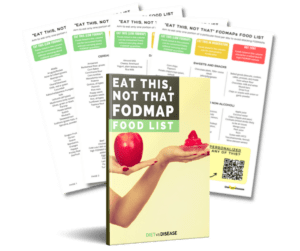Have you been following a Low FODMAP diet for months — or even years — because it’s the only thing that keeps your symptoms under control? If so, then this article is for you.
What most people don’t realize is that staying in the elimination phase long-term isn’t just unsustainable — it’s actually dangerous for your gut health. Most doctors won’t tell you this, and most websites don’t explain it properly.
There’s a reason the Low FODMAP diet has specific phases, and skipping the reintroduction phase can leave you worse off than when you started. In this article, we’ll explore exactly why staying restrictive forever backfires, what it’s doing to your gut bacteria, and how to safely expand your diet without bringing back the symptoms that scared you in the first place.
Here is a video we made, otherwise there is a written version underneath.
The Elimination Trap – Why Symptom-Free Doesn’t Mean Healed
Here’s what happens to most people: They start the Low FODMAP diet, and for the first time in years, they feel normal.
No bloating. No cramping. No unpredictable bathroom trips. And they think: “My gut is healed. Case closed.”

So they stay in elimination mode indefinitely. But here’s the problem — symptom-free doesn’t mean healed. It just means you’ve removed the triggers.
Imagine your smoke alarm is blaring and you can’t stand the noise, so you rip it down from the ceiling and remove the batteries. Problem solved, right? Kind of, but chances are there’s still something burning in your house that set it off in the first place — that’s the real problem you need to fix.
The Low FODMAP diet is like removing the batteries from that smoke alarm. It stops the noise, but it doesn’t address what’s actually causing the fire.
Why People Stay Restricted Too Long
It’s completely natural to want to avoid bringing back symptoms when you’ve been suffering for years and finally find relief.
When you’re not feeling good for so long and then suddenly experience symptom relief, you’re scared to bring back foods. You don’t want your symptoms to return, and you don’t know exactly what was causing them.
There’s also a lack of information available about why reintroducing foods is important in the whole process. Many doctors don’t adequately explain the reintroduction phase or its critical importance.
Summary: The elimination phase provides symptom relief by removing triggers, not by healing the underlying issues. People naturally want to stay in this “safe” zone, but this approach doesn’t address root causes and can lead to long-term problems.
The Critical Timeframe – When to Start Reintroduction
The 75% Rule
If your symptom improvement is 75% or more, and for the majority of your time, you’re symptom-free, that’s the right point to start reintroducing foods.
You want to do this slowly and strategically because if you add everything back at once, you won’t know which foods are actually triggering your symptoms.
The Four to Six Week Window
Generally speaking, you should be in the elimination phase for four to six weeks maximum. There are some instances where it can be slightly longer, but you should really be monitored by a healthcare professional during this time.

As mentioned by nutrition experts, there are other things that extended restriction can start to affect, like your gut microbiome and nutrient deficiencies. For some people, four weeks is sufficient, while others may need six or maybe even eight weeks, but really, any longer than that shouldn’t happen unless there are extreme circumstances.
Why Professional Guidance Matters
It’s helpful to have a dietitian or healthcare professional walk you through the reintroductions because there are so many other factors that could impact your gut and trigger certain reactions.
Having a second set of eyes to help identify what might be contributing to symptoms that appear when you’ve been symptom-free is invaluable.
Summary: The elimination phase should last only 4-6 weeks maximum, with reintroduction beginning when you achieve 75% symptom improvement. Professional guidance is crucial for navigating this process safely and effectively.
What Long-Term Restriction Does to Your Gut Bacteria
The gut microbiome is the community of trillions of microbes living inside your large intestine. They help with digestion, immune function, vitamin production, and even mood and brain health.
When you stay on an overly restrictive diet like Low FODMAP for too long, you starve the very bacteria that keep your gut healthy.
This imbalance is called dysbiosis, and it’s not just about bloating or constipation — it’s linked to inflammation, food sensitivities, and chronic diseases like arthritis, diabetes, and even cognitive decline.
Understanding Your Gut Ecosystem
Think of your gut microbiome as an ecosystem, like a forest. Every little aspect plays a role, no matter how small. If something goes out of whack for whatever reason — whether it’s age, stress, medications, or restriction — the ecosystem shifts and changes. The habitat for certain organisms might not be able to support them as efficiently as before.
When you restrict fiber-rich foods long-term, you’re essentially removing entire food sources from your ecosystem. You’re starving the beneficial bacteria that break down complex fibers.
The Vicious Cycle
Imagine if someone removed all the nuts and berries from a forest. The squirrels would leave or die off. Then the animals that depend on squirrels would struggle. The whole ecosystem becomes less diverse and less resilient.
Here’s the kicker: when you finally try to reintroduce those foods, you no longer have the right bacteria to process them properly. So you get more symptoms — not because the foods are inherently bad for you, but because your gut ecosystem can no longer handle them.
Summary: Long-term FODMAP restriction starves beneficial gut bacteria, creating dysbiosis that leads to a weakened gut ecosystem. This makes reintroducing foods more difficult and can worsen symptoms over time.
If you’re just getting started, download our free Low FODMAP food list to get clarity on common gut triggers
Tap the blue button below to download our “Eat This, Not That” list as well as additional resources for bloating (it’s free!)

Real-Life Impact That’s Beyond Physical Symptoms
Staying overly restrictive affects your entire life in ways that go far beyond physical symptoms. When you’re so restrictive that you can’t branch out, it creates social impact and emotional impact that affects many different aspects of your life.
The restriction itself becomes a problem — you start avoiding restaurants because “there’s nothing safe to eat.”
You stop traveling because you can’t control the food. You decline dinner invitations, family gatherings, and social events. Slowly, your world gets smaller and smaller.
The Development of Food Fear
Long-term restriction can bring up significant fear around food. You become scared of foods because you don’t know what’s going to happen if you eat them.

Your relationship with food shifts from “all foods are good in certain moderation or portion sizes” to “I can’t eat this food because I don’t know what will happen.”
This brings a lot of fear, and you end up thinking about food restrictions all the time. You’re worried about branching out at all because of the potential consequences, and this can be really isolating.
The Path to Disordered Eating
When you’re restricted for so long, it can skew how you think about food, which could potentially develop into disordered eating patterns or, in worst-case scenarios, full disordered eating behaviors.
The constant mental energy spent calculating and restricting, the food anxiety, and the social isolation all contribute to what can only be described as “food prison.” The irony is that the longer you stay restricted, the harder it becomes to break free.
Summary: Long-term FODMAP restriction creates social isolation, food anxiety, and can lead to disordered eating patterns. The mental and emotional toll often becomes more challenging than the original digestive symptoms.
Best Solution – Strategic Reintroduction and Gut Rebuilding
The answer isn’t to simply “add everything back” and hope for the best. Breaking free from long-term restriction requires a strategic, step-by-step approach to rebuilding your gut’s tolerance safely.
4-SURE Pathway Approach
This comprehensive solution involves four key steps:
- Symptom-free — Getting you stable first with appropriate restriction
- Understand — Identifying your actual root causes through proper testing
- Reintroduction and Rebuild — Guiding you through systematic diet expansion
- Eat with freedom — Rebuilding a resilient gut that can handle variety again
We use this with our clients and find it to be highly effective. This approach primarily focuses on personalization and ensures that the root cause is addressed.
The Real Goal
The goal was never to keep you restricted forever.
The goal is food freedom — being able to travel, eat out, and enjoy family meals without fear. This isn’t just about managing symptoms; it’s about reclaiming your life and building true gut resilience.
Summary: Successful transition from restriction requires a strategic, phased approach that addresses root causes while systematically rebuilding food tolerance and gut resilience.
What Should You Do Next?
If you’ve been stuck in elimination mode for months or years, feeling “safe but scared” to expand your diet, it’s important to know that you can safely rebuild your food variety and gut strength.
With the right guidance, you’ll start to notice how meals become enjoyable again instead of anxiety-provoking, how your social life expands as food fear diminishes, and how you stop living in constant worry about what you can and cannot eat.
If you suspect that staying in long-term restriction is actually weakening your gut rather than healing it, we’re here to help you.
To learn more, I invite you to apply for a nutrition assessment call with us. We’ll help you make sense of what’s really happening beneath the surface and map out the next steps to get you feeling better — not just temporarily managing symptoms, but addressing the root causes for lasting change.

I am just starting FODMAP. How do I find a qualified dietitian knowledgeable about FODMAP to work with?